Preserve the Peace
 DISTURB THE
PEACE. That’s what terrorists do. And that’s
what SONY does. They have gone so far as to trademark the phrase, paste
it on SONY products, and proclaim it from the pages of magazines and
newspapers. What they are doing is marketing incivility along with their
SONY mobile car stereo products. DISTURB THE
PEACE. That’s what terrorists do. And that’s
what SONY does. They have gone so far as to trademark the phrase, paste
it on SONY products, and proclaim it from the pages of magazines and
newspapers. What they are doing is marketing incivility along with their
SONY mobile car stereo products.
PRESERVE THE PEACE. That's
what we do. And we want you to join the effort. Join our Preserve the
Peace Campaign.
THE PROBLEM:
Boom cars are concerts with wheels. Their loud stereo systems can be
heard long before the car can be seen. These car stereo systems,
capable of being played at deafeningly loud levels, are marketed as
sexy and rebellious.
An entire set of magazines, including Car Sound and Performance,
Car Audio, Car Audio and Electronics, and Auto Sound and
Security, has sprung up with the industry. These magazines, like
the boom car systems they sell, are aimed at an audience high on
hormones, whose system just isn’t big enough.

Sex sells, and sex sells car stereos. The ratio of flesh to fabric
of the women photographed in the December issue of Car Sound and
Performance is greater than 10 to 1. They are selling din by
showing skin.
Incivility and rebellion also sell car stereos. The enemy is your
sleeping neighbor, your parents, anyone over 40, and Peace and Quiet.
Just as the tobacco companies before them, the car stereo industry
has found a way to coopt and capitalize on rebellion. When
multinational corporations incite rebellion, you can be sure it isn’t
rebellion against injustice or rebellion against war. Nor is it the
rebellion of 1776. There is no cause but to disturb the peace.
This corporate co-opted rebellion is a rebellion against neighbors.
It is a rebellion that doesn’t ask for a sacrifice and doesn’t
hope to make the world better. It has no goal but to be heard and
seen. Its value is measured in decibels and corporate profits.
The worst corporate offender by far is SONY. SONY’s Disturb the
Peace ads for amplifiers and speakers that offer “ALL NEW WAYS TO
OFFEND,” are designed to appeal to people who feel they are not
receiving the attention they are due. The primary purpose of a
300-watt car stereo amplifier, 10 times more power than the Beatles
originally used in concert, is to make you notice them.
Boom cars scream into our neighborhoods, “I am here—look
at me—you can’t do anything about it.” Their message is
all about power. Boom cars are to our streets as bullies were to our
schoolyards. They beat you up with decibels instead of fists. They
make your chest shake and your ears ache. Boom car owners feel
powerful at the expense of their neighbors.
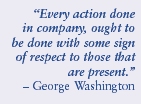
Civility is all about acknowledging others and treating them with
respect, as you would like to be treated. The incivility associated
with SONY’s sales pitch is all about forcing others to
acknowledge your presence. This sales pitch isn’t coming from a
neighborhood thug, but a corporation that is a guest in our country. A
very big guest. Fortune Magazine ranked SONY the 69th largest
company in the world, and number 6 on the Global Most Admired
Companies list. Fortune, of course, doesn’t consider corporate
responsibility a prerequisite for being admirable.
THE SOLUTION: PRESERVE THE PEACE
NPC created the Preserve the Peace campaign as an antidote to SONY’s
Disturb the Peace advertising. The first phase of the campaign,
planned for this spring and summer has three components.

- NPC has sent a letter to SONY Corporation of America’s
Chairman and CEO, Howard Stringer, and SONY’s Chairman of the
Board in Japan, Norio Ohgaony. We’ve asked them to:
- Donate the “Disturb the Peace” Trademark to NPC.
NPC will hold the trademark in a “Quiet Trust,” never
to be used again.
- Stop marketing incivility.
- Contribute to Peace and Quiet.

- NPC is collecting letters from friends of quiet like you to send
to SONY’s CEO and Chairman of the Board, similar to the NPC’s
letter. We hope to mail five to ten letters a day to SONY. (Please
return the enclosed letter to us in the envelope provided.)
- NPC is encouraging local communities to pass and enforce boom car
ordinances. (See article on page 6.)

The second phase of the campaign will be announced this summer if
the first phase is not successful. (We don’t want to tell SONY
all of our plans just now, but it's safe to assume that NPC will use
media events to associate SONY with the incivility SONY promotes.)
Here is what you can do to contribute to the Preserve the Peace
campaign.
For starters:
- Sign and return the letter for SONY’s Chairman of the Board
and CEO to the Noise Pollution Clearinghouse. We will send the
letter to SONY America and a copy to Japan, with about five other
letters each day.
- Mention SONY Corporation’s marketing of incivility at every
chance you get.
The next step:
- Call your local city council member or mayor and encourage them
to either pass a boom car ordinance, or enforce an existing one.
Share the boom car noise ordinance recommendations and the list of
communities that have adopted boom car ordinances (see page 6) with
them.
For the really committed:
- Bring five or more people into the Preserve the Peace campaign.
We are looking for 1,000 people who will each bring five more
concerned citizens into the movement. Check the box on the enclosed
return envelope to tell us you want a Preserve the Peace Packet to
distribute to your friends and neighbors. If you want more than
five, write the number in the space provided.
- Contribute to the Preserve the Peace fund. Include a donation to
the Noise Pollution Clearinghouse. Help us pay for the work of
Preserving the Peace.
|
FIVE REASONS WE WILL SUCCEED
So, is there any hope in taking on one of
the biggest companies in the world? Absolutely. Here are five
reasons why we will succeed.
- SONY’s size is their disadvantage. Boom cars are
universally hated by everyone but the people driving around in
them. The same people that hate boom cars buy thousands of SONY
products. The Disturb the Peace advertising campaign is small by
SONY standards and would be jettisoned quickly if it were
harmful to the larger SONY image. (See the list of SONY products
on page 4)
- SONY is a guest in our country. SONY is based in Japan, a
country legendary for the politeness of its people and for
religions that celebrate quiet. SONY doesn’t want to
represent either itself or its country as being impolite.
- SONY projects itself as an environmentallyfriendly company
and wants to protect that image.
- Howard Stringer, SONY Corporation of America’s Chairman
and CEO, is an environmentalist and by all accounts a nice guy.
He was on the Board of Governors of the Nature Conservancy. He
has a deep commitment to preserving natural landscapes; we need
to convince him to preserve natural soundscapes too.
- SONY is worried that Disturb the Peace could be associated
with other SONY products. You won’t find Disturb the Peace
on SONY’s website. You won’t find it in SONY’s
annual report. You only find it in advertisements to selected
target markets. And now, with the Preserve the Peace Campaign,
it will increasingly be associated with SONY Corporation unless
Sony decides to do the right thing.
|

|
Do you unknowingly support Sony?
The answer is yes, if you... |
Listen to music from these
record labels:
Sony
Columbia
Epic
Legacy
Nashville
Watch movies from these companies:
Columbia
Tri-Star
Sony Classics
Screen Gems
Watch these TV shows:
Battle Dome
Bewitched
Boston Bay
Capeside HS
Classic Charlie's Angels
Couch Potatoes
Dawson's Creek
Days of our Lives
Donny & Marie
Fantasy Island
I Dream of Jeannie
JEOPARDY!
Judge Hatchett
Mad About You
Men In Black: The Series
News Radio
Party of Five
Ricki Lake
Seinfeld
Sheena
Soapcity
V.I.P.
Walker Texas Ranger
Wheel of Fortune
Worthington Univ Bookstore
The Young and the Restless |
Play games on:
Sony Playstation
Sony Playstation 2
Play any of these Sony games on the internet:
Jeopardy!
Wheel of Fortune
Trivial Pursuit
Everquest
Star Wars Galaxies
Buy any of these electronics devices and accessories
manufactured by Sony:
Cameras
Video Cameras
Computer Monitors
CD players (including portable)
DVD players
MiniDisc Players (including portable)
Audio tape players (including portable)
Radios (including portable)
VCRs
TVs
Headphones
Blank audio tapes and CDs
Film
Floppy disks
Phones
Batteries
Buy products from these Sony subsidiaries:
Aiwa
Columbia House
Sony Ericsson Mobile Communications |
| Sony's
average annual sales perhousehold is $160. |
Boom Car Basics:
What you and city officials need to know
What is a boom car? Basically,
a boom car is any vehicle with a loud stereo system, which almost
always requires some modification to the original stereo. More and
bigger speakers, capable of playing at much louder volumes, are added
to the car. These boom cars are a health and safety risk to the
occupants, other drivers, neighbors, and city emergency and rescue
personnel.
Most of the generic stereo systems delivered in new cars have radios
(with CD players and/or tape players) capable of putting out about a
total of 25 watts of power into two pair of little speakers, usually 4
to 6 inches in diameter. These speakers are used to play all the
frequencies of the music.
THE MAKING OF A BOOM CAR
Making a car louder can be cheap and easy, requiring only a
hundred-watt stereo amplifier and a couple of efficient low-frequency
speakers. Installing the new parts is easy and can require little or
no modification to the car. The addition of several speakers and
several hundred watts of power may require installation by a
specialist and is quite expensive.
In modifying a stereo system, people often start by adding a bass
speaker (bass driver) to emphasize the low-frequency notes from the
bass and drums in music. They’ll add a crossover, a device which
filters signals based on frequency, to separate the low notes from the
rest of the music, and an amplifier to drive the added speaker.
After the bass drivers have been added the original speakers are
often changed, and more power added, so that what are now the
mid-range speakers will play louder. Separate tweeters may also be
added, with their own amplifiers and crossovers, to get the high
frequencies to play at the same sound pressure levels as the rest of
the system. A big system can have multiple bass drivers, and several
mid-range drivers and four or more tweeters. After all the amplifiers
and speakers have been added to a boom car, a car alarm is often added
to safeguard the stereo system that is often worth more than the car.
BOOM CARS BY THE NUMBERS Turning
the volume all the way up in a car with its original stereo might
produce 100 dB, but mostly you’ll hear a lot of distortion. A
typical stationary or slowmoving car with the radio turned off has an
interior sound pressure level of 50-60 dB (all measures presented here
are with windows shut). Driving the car on the street or highway gives
about 60-70 dB — mostly wind, tire and engine noise — inside
the car. Drivers generally set their stereo to 6-10 dB over interior
noise levels. Therefore, typical interior levels with the stereo
playing are 60-80 dB.
Most of the noise of an original stereo system is trapped inside the
car, especially when the windows are shut. Sound pressure levels for a
typical car are about 40 dB less 50 feet from the car than they are
inside the car (measured to the side of the car with speakers in the
door). So if you listen to your radio at 70 dB, the outside level is
about 30 dB. The noise from the car traveling at 30 mph at 50 feet is
about 60 dB, so the resulting stereo levels outside are lost in the
background noise.
A boom car, however, really stands out. Boom cars have been measured
at sound pressure levels in excess of 170 dB. It is not uncommon for
interior levels to exceed 110 dB. In car stereo competitions, loudness
points are awarded up to 130 dB. Often these cars are parked in a
public area with the doors and trunk open and a party going on nearby.
A moving boom car can be heard coming and going for blocks from the
listener.
Just as a typical car traps most of the noise from standard sound
systems inside the car, most of the outside noises cannot be heard
inside a car. The background levels inside the car are already quite
high (50-70 dB, possibly 80 dB with a fan and stereo going) and the
typical car attenuates or reduces outside noises by about 30 dB. The
only outside sounds people need to hear in their car are police,
ambulance and emergency sirens as well as horns honked in emergencies.
Typical interior sound pressure levels from sirens and horns peak at
about 75 dB. At interior car stereo sound pressure levels much greater
than 80 dB, emergency warning devices are masked by the sound system.
Drivers do not have time to safely react to emergency warnings.
REGULATING BOOM CARS
Controlling the noise from boom cars, therefore, is not just an
effort to increase community peace and quality of life, but also an
effort to enhance public safety and the safety of emergency and rescue
personnel. If you can hear a boom car as it passes by at 50 feet, not
only is the car disturbing the neighbors and deafening the occupants
but it is also masking emergency warning signals.
Typical sound-pressure-level-based noise ordinances are ineffective
against boom cars, because the cars are mobile. By the time the police
officer goes back to the police station, gets the meter, calibrates
it, and takes a measurement, the violator is miles away. In addition,
low-frequency noise—the boom of boom cars—is not picked up
by sound level meters that are set on the “A” scale, which
is used in many communities. There is, however, a simple solution that
has been adopted by hundreds of communities that is easy to enforce.
In the accompanying article on page 7, Eric Zwerling of the Rutgers
Noise Technical Assistance Center describes the “Plainly Audible”
standard that has been adopted by hundreds of communities.

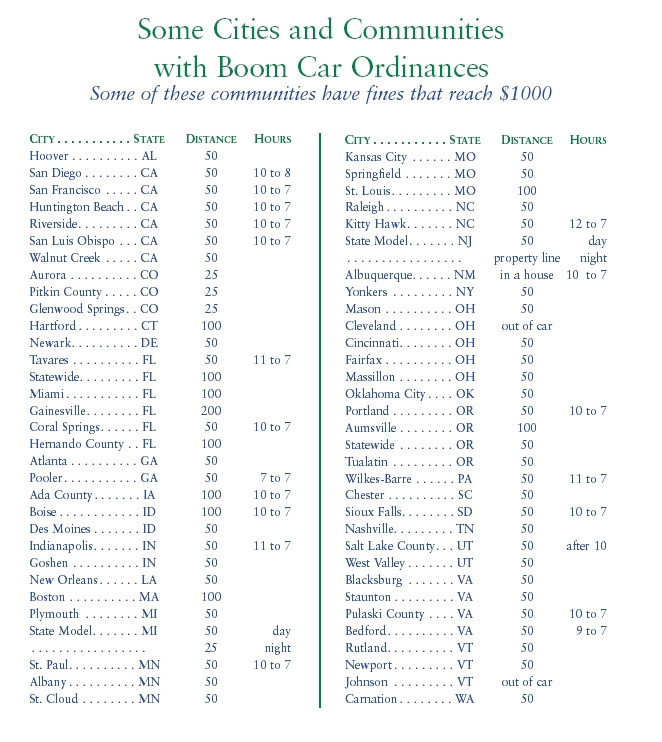
Boom Car and Boom Box Code Drafting
Enforcement of a performance (decibel denominated) standard is
difficult with boom cars and boom boxes, as the sound is transient and
the source is mobile. While some jurisdictions enforce a curbline
sound level limit, the enforcement agency must set up in advance in
the location at which they suspect a violation may occur. While
enforcement and deterrence is extremely effective during the operation
of such an enforcement action, it is only effective at the time and in
the place this action occurs. Outside of these parameters, deterrence
is minimal.
An alternative enforcement standard is required to address this
specific sound source, if enforcement is to be regular and
predictable, thus providing the desired deterrence. When the deterrent
is not successful, the enforcement standard must lead to successful
prosecution. After a careful review of precedents and challenges in
other jurisdictions, it was clear that any successful standard would
have to be objective, specific and easily understood. A “plainly
audible” standard has been applied in numerous jurisdictions
across the United States, and this standard has been held to be
neither vague nor overbroad (State v. Ewing, 914 P.2d 549, Haw. 1996).
It is also clearly understandable to those it is intended to regulate.
Using this standard, subjective value judgments associated with
ordinances that rely on finding a noise “disturbing” or “loud
and raucous” are avoided.
| A “plainly audible” standard
has been applied in numerous jurisdictions across the United States,
and this standard has been held to be neither vague nor overbroad
|
CODE PROVISIONS
Definition
“Plainly audible” means any sound that can be detected by
a person using his or her unaided hearing faculties. As an example, if
the sound source under investigation is a portable or personal
vehicular sound amplification or reproduction device, the enforcement
officer need not determine the title of a song, specific words, or the
artist performing the song. The detection of the rhythmic base
component of the music is sufficient to constitute a plainly audible
sound.
Restricted Uses And Activities
- Personal or commercial music amplification or reproduction
equipment shall not be operated in such a manner that it is plainly
audible at a distance of 50 feet in any direction from the operator
between the hours of 8:00 a.m. and 10:00 p.m. Between the hours of
10:00 p.m. and 8:00 a.m., sound from such equipment shall not be
plainly audible at a distance of 25 feet in any direction from the
operator.
- Self-contained, portable, hand-held music or sound amplification
or reproduction equipment shall not be operated on a public space or
public right-of-way in such a manner as to be plainly audible at a
distance of 50 feet in any direction from the operator between the
hours of 8:00 a.m. and 10:00 p.m. Between the hours of 10:00 p.m.
and 8:00 a.m., sound from such equipment shall not be plainly
audible by any person other than the operator.
|
These code recommendations come from Eric Zwerling,
President of the Noise Consultancy, which specializes in helping
communities write enforceable noise ordinances. For a full
discussion of this topic, see the paper "Regulation of
Amplified Sound Sources" which originally appeared in the
Proceedings of Noise-Con 2000. For a copy contact the Noise
Pollution Clearinghouse. |
Full-Color Insert -- Click here for the
PDF version.

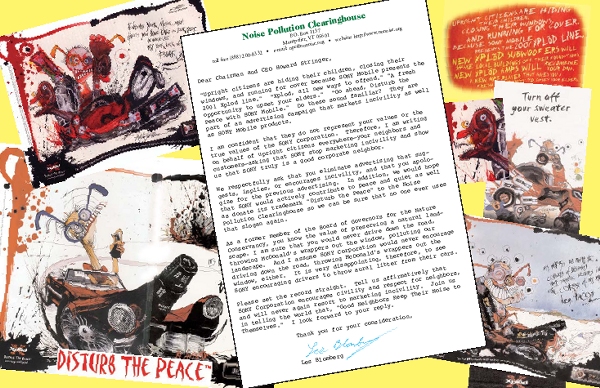
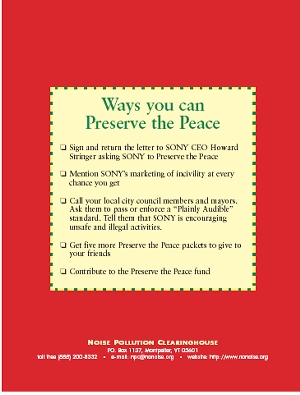
Airport Monitor
|
WWW.AIRPORTMONITOR.ORG
What are the latest bills concerning airports? Are there any new
regulations proposed for your airport? What have your
representatives said about aviation noise on the floor of the
House or in a congressional hearing? After March 30, 2002 you will
find answers to all these questions, plus many more resources, at
the NPC’s newest website: AirportMonitor.org.
Airport Monitor is a website developed to inform and facilitate
grassroots participation in federal aviation and aviation noise
issues. It consists of an online library/database of federal laws,
regulations, legislation, executive orders, and rulemakings
concerning airports and aviation. Airport Monitor alerts users of
all aviation- related notices in the Federal Register on the same
day that they are published, and it will alert users of
legislation impacting their concerns the day after it’s
introduced.
This information is organized into the following categories:
aviation, aviation noise, helicopters, and helicopter noise. In
addition, there is a category for each of the 100 airports the FAA
would most like to expand, so you can follow developments at your
local airport.
Airport Monitor will also provide a collection of comments from
Senators and Representatives regarding aviation from the
Congressional Record as well as transcripts of relevant Committee
Reports and Hearings. Finally, it will provide an up to date
calendar of all comment periods and due dates related to aviation.
In addition to the website, beginning this summer, Airport
Monitor will send registered users an email once a week with a
summary of federal government activity at your airport and in your
areas of interest (helicopter noise, for example). The email will
include a short description of new federal documents with links to
the full document on the Airport Monitor site.
Airport Monitor is one more tool to help those impacted most by
aviation noise to regain control of a system that is out of
control. Beginning in early March, NPC will be testing an early
version of the site. We invite you to look at it and let us know
what you think. All features should be available by this summer. |
WHY THE FAA NEEDS A BABYSITTER
On July 14, 2000, at the peak of summer vacations, the FAA
quietly released its draft Noise Abatement Policy for a six-week
comment period. The policy was last revised 25 years ago and
probably won't be revisited for another 25 years. The FAA policy
was actually more effective at abating the efforts of noise
control activists than abating aviation noise. The policy sought
to further limit citizen participation in aviation noise control
decisions while allowing more noise and easier expansion at
airports.
Unfortunately, because of limited resources and the broad scope
of noise problems, no individual or organization in the anti-noise
community watches the Federal Register on a daily basis, so the
document went unnoticed for nearly two weeks. By the time the
Noise Pollution Clearinghouse and other activists had found and
assessed the importance of the 25,000-word document, it was too
late to begin a direct mail campaign to aviation noise activists.
Although we eventually received an extension, the FAA didn't
announce the additional six-weeks for comments until the end of
August, ensuring that activists had as little time as possible to
initiate a large campaign.
Short comment periods that require immediate action are the
rule, whether its the FAA's Noise Abatement Policy or the National
Park Service’s December 18th release and January 17th
deadline for comments on the phase-out of snowmobiles from parks.
Each week, environmentalists and airport activists miss
opportunities to shape public policy because they do not have the
resources to keep informed and immediately mobilize their
constituents.
Because of these problems, NPC has been formulating ways to keep
better track of comment periods, bills, and rulemakings for more
than two years. We know that there are hundreds of airport noise
organizations in the same situation. Now, NPC will keep them
updated so that they do not have to search the Federal Register,
proposed bills, executive orders, and rulemakings on their own.
Airport Monitor will immediately identify opportunities for
public participation and enable individuals and groups, when
opportunity strikes, to generate hundreds or thousands of comments
from like-minded individuals. Next time we will be ready, and so
will you and hundreds of other individuals and non-profit
organizations. |
The Failure of America's Aviation
Noise Policy
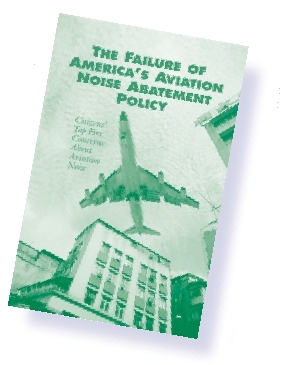 This
spring, the Noise Pollution Clearinghouse is releasing a report, The
Failure of America’s Aviation Noise Abatement Policy: Citizen’s
Top Five Concerns about Aviation Noise. This report is a study of the
response to the FAA’s draft Noise Abatement Policy. It is written
by Les Blomberg, Executive Director, and James Sharp, Senior
Researcher at NPC. This
spring, the Noise Pollution Clearinghouse is releasing a report, The
Failure of America’s Aviation Noise Abatement Policy: Citizen’s
Top Five Concerns about Aviation Noise. This report is a study of the
response to the FAA’s draft Noise Abatement Policy. It is written
by Les Blomberg, Executive Director, and James Sharp, Senior
Researcher at NPC.
The study exposes the aviation industry and the Federal Aviation
Administration (FAA), its federal regulatory body, as oblivious of the
true impact aviation noise has on the public who live near airports
and ignorant of the science of noise impact assessment. Based on the
technique of content analysis applied to the 1,261 public comments
received by the FAA concerning its draft Noise Abatement Policy 2000,
this study finds that the overwhelming majority of commenters believe
the FAA’s noise abatement policy is a failure. 96% of the more
than one thousand people who submitted comments to the FAA believe the
draft Noise Abatement Policy will not adequately protect citizens from
aviation noise. The major findings include:
- Aviation noise is getting worse
- Nighttime flights and sleep interference are citizens’
greatest concern
- Aviation noise is imposed on neighbors unjustly
- Significant impact begins well below the 65 DNL level
- Local control of airports should be increased
The Noise Pollution Clearinghouse is looking for airport noise
activists to help publicize this report in local communities. NPC will
make about a 1,000 copies of the report available to local activists,
and it will also be available on our website at
www.nonoise.org/library/failure.htm. The publication date is set for
April. NPC will coordinate national media exposure and hopefully local
airport activists will also gain local exposure.
To sign up to receive an advance copy of the report so you can be
part of the media effort, go to the NPC website
(www.nonoise.org/failure/) and fill out the form or call
1-888-200-8332.

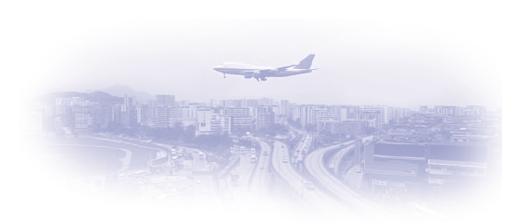 Aviation
Noise and Safety Aviation
Noise and Safety
September 11th and the tragic crash of a plane in Queens brought a
dramatic change in aviation policy and security. For the 7,500
commercial aircraft in the United States, security is a much higher
priority. Unfortunately, the 200,000 general aviation aircraft have
not received the same attention. When it comes to general aviation,
the FAA and aviation industry have taken a “pray it never happens”
attitude. This means less safety and more noise for those on the
ground. Airport neighbors need to recognize just how closely noise and
safety are related.
The airline industry reacted quickly to the September attacks and
immediately secured a 15 billion dollar bailout from the US Congress
and President Bush. In what many take as a clear signal of relative
priorities, the Congress took a lot longer to pass an aviation
security bill. Nevertheless, they have begun implementing many of the
aviation security measures recommended by the Gore Commission after
the crash of Flight 800, solutions that the industry and some of the
more conservative members of Congress rejected as unnecessary and too
costly just a couple of years ago.
Most of the burden of increased safety has fallen on the public
through a decrease in liberties and privacy, and an increase in tax
money spent to make the airlines safer. The FAA is much more willing
to search your luggage than it is to impose safer flight routes. In
the aftermath of the crash in Queens, the FAA is just beginning to
realize that it is safer to route planes over water than over homes.
Ocean routing and over-water flight paths, which promise to reduce
noise and increase safety for millions of people living on both
coasts, is not yet being seriously considered.
Nowhere, however, is the resistance to assessing the risks and
taking appropriate safety measures as great as in the area of general
aviation. The FAA’s Report to Congress, Improving General
Aviation Security highlights the problem, but it doesn’t make a
single recommendation as to what to do about the problem. The industry’s
line is that these planes aren’t big enough to cause the damage
done to the World Trade Center.
It doesn’t take a big plane to cause big problems, however. A
small crop duster, if flown over a 70,000- person baseball or football
stadium — even if it was spraying nothing but water — could
initiate panic and chaos sufficient to kill hundreds of people. Even
the FAA’s report recognizes the danger of small craft carrying
explosives. The report states, “General aviation aircraft could
be used to strike ground-based targets. Their load-carrying ability,
even if limited, enables the delivery of explosives, compensating for
their relative lack of kinetic energy or fuel.” In fact, many
general aviation aircraft can carry twice the explosives used to bring
down the Federal Building in Oklahoma City.
The scale of the problem is enormous. “There are over 200,000
general aviation aircraft in the United States operating from over
18,000 airports,” according to the FAA report. Many of these
airports have few security measures. And once these aircraft are in
the air, it’s like the wild west. They are not restricted from
flying over many vulnerable targets. For some there are no minimum
height restrictions. And there are no state police or local sheriffs
patrolling the sky.
And the problem is growing. As commercial flights become less
convenient, companies and the rich are opting out of commercial
aviation and purchasing the equivalent of time shares in private
aircraft. Barron’s reports, “Since September 11, interest in
taking partial ownership in private jets has increased sharply.”
Orders are up for planes that do not have to meet Stage III noise
requirements and that carry significantly fewer people, which means
more noisier planes taking off and landing to move fewer people. This
is the next big aviation noise problem.
Private jets are the aircraft best suited to carry explosives and
threaten urban buildings, power plants, pipelines, and dams. Before
the September attacks, the FAA used to brag that 8,000 aircraft passed
within 50 miles of the Empire State Building each day. Now we know
that that is a problem. Planes that are not taking off or landing
should not be over a metropolitan area, and general aviation aircraft
should not be able to fly wherever they want, whenever they want, and
without the FAA knowing exactly where they are at all times. This is
what the anti-noise-pollution community has been saying for years. It
is time we join with the environmental and public safety advocates to
reduce noise and increase safety at the same time.
Perhaps the greatest threat from general aviation is to nuclear
power plants. On the ground nuclear power plants have fences,
barriers, and a security team in place to prevent a Ryder truck bomb
from being crashed into the reactor, control building, or radioactive
waste. The fences are only 12 feet high, however, and provide
absolutely no defense against an airborne attack. There are thick
reinforced containment walls around some parts of nuclear plant, but
generally not around important facilities that control the operation
of the plant and not around the waste.
The Germans have been much more honest about the impacts of air
attacks on nuclear plants than the U.S. Government, aviation industry,
or nuclear industry. The spokeswoman for the association of German
electric power utilities said, “No power plant in the world could
withstand an airborne terror attack like the one on September 11.”
Edwin Lyman from the Nuclear Control Institute in Washington said, “The
possibility of an unmitigated loss-of-coolant accident and significant
release of radiation into the environment is a very real one.”
Physics Today reports, “Experts fear a commercial commercial jet
could breach reactor containment walls.”
Two of the biggest and most powerful industries in the country, the
airline and nuclear power industries, are trying to avoid additional
restrictions being placed upon them. The Aircraft Owners and Pilots
Association (AOPA), for example, has mounted a multi-million dollar
campaign to protect their “right” to fly wherever they want.
A recent AOPA fundraising letter highlights an industry that is
preparing for future damage control, not for increased public safety.
“Even though we are back in the air [after September 11th], I
fear the potential ramifications if another incident occurs. The
government’s finger is on a button, ready to shut down general
aviation once again with even harsher restrictions, if something else
happens.”
The AOPA is conducting this type of damage control with political
action committees working behind the scenes in Washington. “Our
success in reopening airspace [closed after September 11th] is due to
AOPA PAC’s efforts.” The letter goes on to state, “Your
contribution will also aid AOPA PAC’s efforts to elect more GA
[general aviation] allies in Congress and expand our political pull
into committees that will have an increasing influence on the future
of general aviation.”
The nuclear industry is also working behind the scenes to make sure
the threat of an airplane attack does not damage the industry,
complicate relicensing, or significantly increase security costs.
Airport noise activists, who are among the best-educated citizens
when it comes to aviation, are well suited to help raise safety
concerns in their communities, and should team up with
environmentalists and public safety advocates to counter irresponsible
industry efforts.
Noise activists and environmentalists are not the only ones
concerned about aviation safety. The Governors of Vermont and New
Hampshire have requested 50 mile no fly zones around nuclear power
plants. Representative Anthony Weiner is trying to get the FAA to move
flights from over Queens to out over the ocean. The New Jersey
Congressional delegation is leading the effort for ocean routing.
With the increase in general aviation, the increased use of private
jets, changes in flight paths, and flights over populated areas,
aviation safety has become an important issue to aviation noise
activists. People should not assume that the FAA is addressing the
safety issue, just as they should not assume the FAA is working to
solve the noise problem. Currently, pilots are only advised not to
loiter over nuclear power plants. Helicopters can still zip in between
skyscrapers. Airports continue to get noisier everyday.
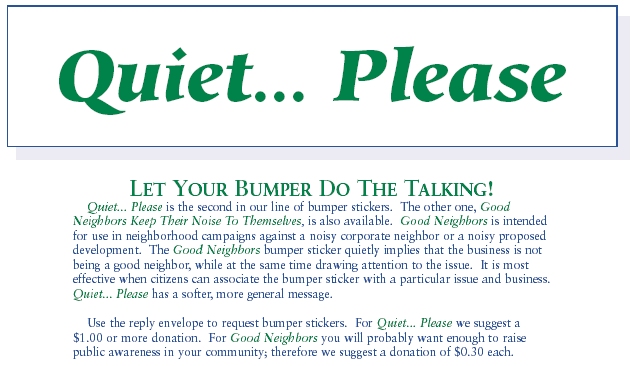 |
 .
.
 DISTURB THE
PEACE. That’s what terrorists do. And that’s
what SONY does. They have gone so far as to trademark the phrase, paste
it on SONY products, and proclaim it from the pages of magazines and
newspapers. What they are doing is marketing incivility along with their
SONY mobile car stereo products.
DISTURB THE
PEACE. That’s what terrorists do. And that’s
what SONY does. They have gone so far as to trademark the phrase, paste
it on SONY products, and proclaim it from the pages of magazines and
newspapers. What they are doing is marketing incivility along with their
SONY mobile car stereo products.











 This
spring, the Noise Pollution Clearinghouse is releasing a report, The
Failure of America’s Aviation Noise Abatement Policy: Citizen’s
Top Five Concerns about Aviation Noise. This report is a study of the
response to the FAA’s draft Noise Abatement Policy. It is written
by Les Blomberg, Executive Director, and James Sharp, Senior
Researcher at NPC.
This
spring, the Noise Pollution Clearinghouse is releasing a report, The
Failure of America’s Aviation Noise Abatement Policy: Citizen’s
Top Five Concerns about Aviation Noise. This report is a study of the
response to the FAA’s draft Noise Abatement Policy. It is written
by Les Blomberg, Executive Director, and James Sharp, Senior
Researcher at NPC. 
 Aviation
Noise and Safety
Aviation
Noise and Safety